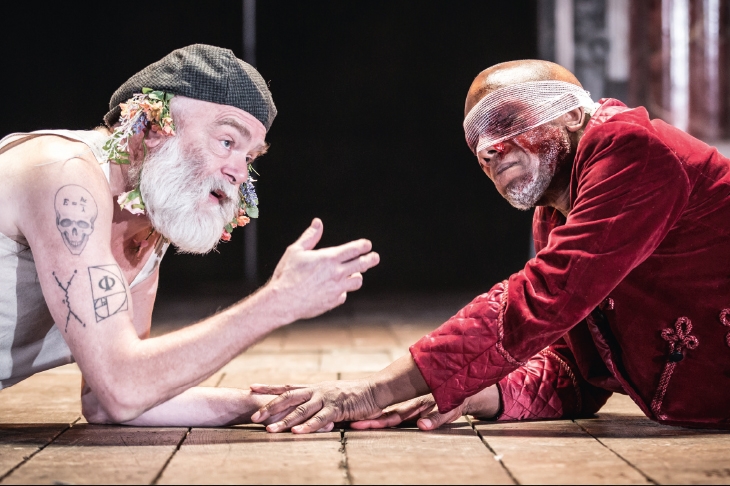A new orthodoxy governs the casting process in Hollywood. An actor’s ethnicity must match the character’s. If you extend this decree to Shakespeare, you need Macbeth to be played by a Highlander, Shylock by a Venetian Jew, Richard III by an English hunchback and Cleopatra by an Egyptian who has slept with her brother. As for Hamlet, the play can only be entrusted to a family of incestuous Scandinavians. Gyles Brandreth (whose name means ‘firebrand’ or ‘sword’ in old Norse) has anticipated the trend by staging a production alongside his son and his daughter-in-law. Benet Brandreth plays the Dane while his wife, Kosha, plays Ophelia, Gertrude, Rosencrantz, Laertes and Horatio. Brandreth Snr takes the older roles.
This amazing stunt includes some genuine discoveries. The trimmed-down text, ingeniously edited by Imogen Bond, deserves to become a standard version for students and am-dram performers wishing to explore the drama with a tiny cast. Gone is the opening scene on the battlements, which never plays as well as it reads. Guildenstern has been cut and Rosencrantz, transformed into a female, works very well as a courtly sexpot whose conquests include both Hamlet and Claudius. Benet Brandreth’s bespectacled Dane looks too well-coiffed to be a murderous, half-mad medieval prince and he roars and flails his arms around a little too readily. The real-life Benet is a barrister and RSC voice coach and he’s at his best here when Hamlet relaxes and larks about with the players. ‘To be or not to be’ is done with great originality. Hamlet recites the opening lines from a book of quotations, and then interrupts himself at ‘aye there’s the rub’ and delivers the rest as if it were commentary on the preceding text. Quite a brainwave.
At times the play’s complexities defeat the experiment. Laertes and Ophelia are merged into a single character with the brother appearing as a figment of his sister’s imagination. It doesn’t quite work although Kosha Engler, amazingly versatile, very nearly pulls it off. The climactic swordfight is played as a drunken game of dare with a whetted fish knife. A more direct and physical solution would have been better. And was it such a good idea to represent Elsinore with a brand-new fitted kitchen?
Brandreth Snr seems absolutely at home playing Claudius, old Hamlet and, especially, Polonius, and yet it’s hard to detach these performances from his comic persona. His magnificent purring voice, like a vintage Jag approaching across loamy moorlands, is all too familiar from Just a Minute and Dictionary Corner. I’d prefer to see his Polonius in a full-scale production. This 90-minute version is a valuable addition to ‘the Hamlet conversation’, but not everyone will appreciate it. Newcomers to the play will simply wonder, ‘Why are these nice, posh English people wandering around a kitchen shouting at each other?’
The Globe’s King Lear is one of the ugliest productions I’ve ever seen. The play is often a punishment rather than a pleasure but this version is pepper-spray painful to watch. Designer Rosanna Vize aims for an industrial look by covering the two forward pillars and the rear elevation with a type of scaffolding fabric known as debris netting. This hides the Globe’s subtle ornamentation in order that the ‘message’ of the design can be broadcast. Here it is: ‘Lear’s realm is being dismantled and rebuilt.’ Yup, we got that.
The costumes are disorganised to the point of absurdity. Why does Gloucester (Burt Caesar) wear a Victorian smoking jacket made for a fatso twice his size? Why has Lear (Kevin McNally) got so much beard? There’s enough there to stuff an armchair. A quick go with the shears is called for. He first appears in a pair of black boots and mismatched army fatigues, and his shaved skull is encircled by a tinfoil coronet of the kind favoured by tramps who believe they are in touch with aliens. The overall look — Grandpa-got-lost-on-his-way-to-the-allotment — may be intentional but the role calls for layers of substance, of menace, of authority, of majesty, or the opening scene will dissolve into a barmy prank. That’s how McNally plays it.
The supporting cast are patchy. Ralph Davis makes an exceptionally cold and arrogant Edmund. The Fool, dressed as Andy Pandy, gets no laughs at all. Emily Bruni is a convincing Goneril, cold, haughty and beautiful. And McNally finds some excellent notes of tenderness and melancholy at the end. He deserves to be in a production designed by an artist rather than by a demolition expert armed with a dressing-up box.







Comments